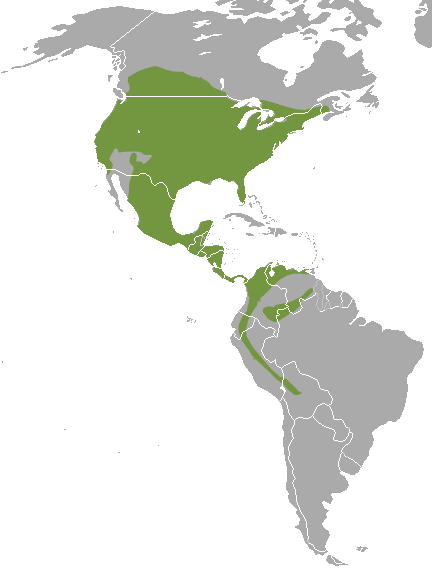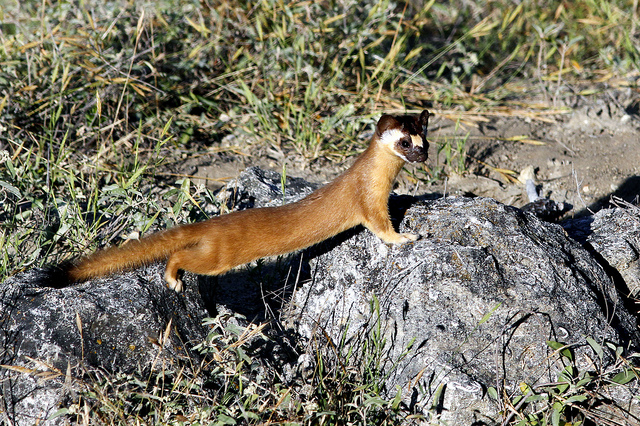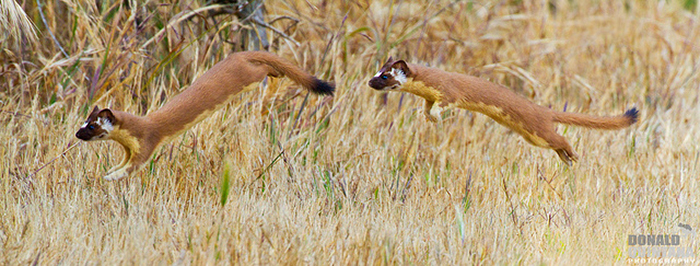Habitat
 The long-tailed weasel can be found all across the Americas!
In fact, Mustela frenata occupies the largest range of
all the Mustelids in the whole Western Hemisphere (Sheffield and
Thomas 1997; Harding and Dragoo 2012). Its northern range
boundary is found just north of the U.S. and Canadian border
(IUCN 2013) at the transition between boreal forests and aspen
parkland (Sheffiled and Thomas 1997). Moving south, the
long-tailed weasel has been found in all 48 continental states
and also all of the Mexican provinces excluding the Baja
California states
(Sheffield and Thomas 1997). Its range continues into all of
Central America and even into the northern countries on the
South American continent (IUCN 2013; Harding and Dragoo 2012)
including: Colombia, Venezuela, Ecuador, Peru and Bolivia (IUCN
2013).
The long-tailed weasel can be found all across the Americas!
In fact, Mustela frenata occupies the largest range of
all the Mustelids in the whole Western Hemisphere (Sheffield and
Thomas 1997; Harding and Dragoo 2012). Its northern range
boundary is found just north of the U.S. and Canadian border
(IUCN 2013) at the transition between boreal forests and aspen
parkland (Sheffiled and Thomas 1997). Moving south, the
long-tailed weasel has been found in all 48 continental states
and also all of the Mexican provinces excluding the Baja
California states
(Sheffield and Thomas 1997). Its range continues into all of
Central America and even into the northern countries on the
South American continent (IUCN 2013; Harding and Dragoo 2012)
including: Colombia, Venezuela, Ecuador, Peru and Bolivia (IUCN
2013).
While Mustela frenata occupies such a large geographic range, it is
generally believed to be common and widespread throughout. Although this
species would not be easy to census, it is estimated to live at a
density of one long-tailed weasel for every 7-40 acres in most areas
(IUCN 2013). In fact, the only place in its geographic range that is not
found is in the Mojave and Sonoran deserts in the Southwest United
States and Mexico (Sheffield and Thomas 1997). In addition, the
long-tailed weasel is less common in areas above an elevation of 610 meters and
in areas of thick forest growth (Adirondack Ecological Center 1988). Populations also fluctuate based on prey, often becoming extinct in some
areas or seasons (IUCN 2013). With these few exceptions, Mustela frenata
live
in all life zones from alpine to tropical, excluding desert
(Sheffield and Thomas 1997).
In additon to a broad geographic range, Mustela frenata also occupies wide ranges of habitat. This species relies heaviley on being close to a fresh water sources, so it is commonly found near rivers, lakes or wetlands. The long-tailed weasel favors habitats such as: brushland and open woodlands, filed edges, riparian grasslands, swamps and marshes (IUCN 2013). This animal is also commonplace in forests, grasslands, fields, ditches and fencerow (Gehring and Swihart 2004). Mustela frenata has few habitat constraints which allows it to thrive in many different areas. Because its habitat requirements are so broad, it usually lives in areas where small rodents such as mice, rabbits, which are its prey, are plentiful. Learn more about its interactions with other species here.
Another aspect of the long-tailed weasel’s habitat is its tolerance
of humans around them (IUCN 2013). Mustela frenata is known to live near
suburban areas as well as in some croplands (Animal Diversity Web 2002).
While it does often live close to humans, it is impacted greatly by
agricultural fragmentation (Gehring and Swihart 2004), draining of
wetlands, and possibly the use of pesticides in agricultural
 areas (IUCN
2013).
areas (IUCN
2013).
Finally, where do long-tailed weasels actually call home? Mustela frenata commonly take control of burrows of its prey (Animal Diversity Web 2002) or abandoned burrows of other mammals (IUCN 2013). It will also often use the fur or other reamains of its den usually for warmth (Cold 1998). When another burrow is not already available, it has been known to live in brushpiles, hollow stumps and logs, and in the spaces between rocks or roots as well. Most long-tailed weasels live in several of these burrows at the same time (IUCN 2013) and has been known to always keep its burrow in tip-top shape (Wisconsin DNR 1998). In fact, weasels actually will never defecate inside its own burrow (Cold 1998).
Back to Classification Go to Adaption
